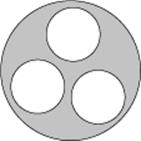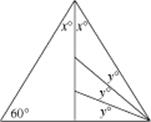Barron's GRE, 18th Edition (2009)
Part 5. MODEL TESTS
Chapter 15. Model Tests
This chapter is designed to give you further experience in what to expect on the verbal, quantitative, and analytical writing sections of the Graduate Record Examination General Test. These tests should serve as a basis for analysis, which for some may signal the need for further drill before taking the actual test, and for others, may indicate that preparation for this part of the test is adequate. For the best results, take these tests only after reviewing your weak areas, found as a result of completing our Diagnostic Test.
Remember that the actual GRE Test you take will be computer adaptive. Therefore, we strongly recommend that, if you purchased this book with a CD-ROM, in addition to completing these model tests, you take a computer-based model test using the CD-ROM. Note that although the model tests in the book cannot be adaptive, each section has the exact same format as the test you will be taking. In each of the model tests in this book, the order of the sections is verbal, quantitative, and analytical writing. On the actual computerized GRE that you take, the computerized sections can appear in any order.
To best simulate actual test conditions, find a quiet place to work. Have a stopwatch or a clock handy so that you can keep perfect track of the time. Go through each section by answering the questions in the order in which they appear. If you don’t know the answer to a question, guess, making an educated guess, if possible, and move on. Do not return to a question that you were unsure of, and do not go back to check your work if you have some time left over at the end of a section. (It isn’t possible to do that on a real GRE.) Practice pacing yourself so that you use all your time and just finish each section in the time allowed. Do not spend too much time on any one question. If you get stuck, just guess and go on to the next question.
After you have devoted the specified time allowed for each section of a model examination, refer to the correct answers furnished, determine your raw score, judge your progress, and plan further study. You should then carefully study the explanations for the correct answers of those questions that gave you difficulty. If you find that a particular topic needs further review, refer to the earlier part of the book where this topic is treated before attempting to take the next model test. If you follow this procedure, by the time you complete the second test in this chapter you will feel confident about your success.
Answer Sheet
MODEL TEST 1
Section 1
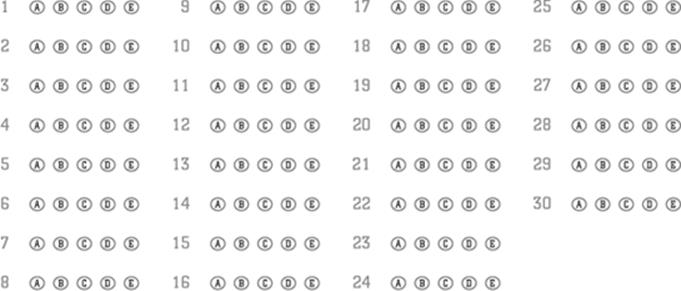
Section 2
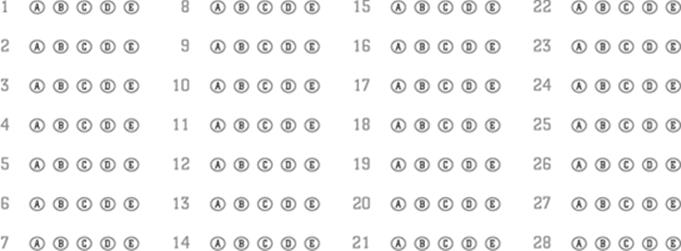
Model Test 1
Section 1 Verbal Ability
TIME: 45 MINUTES—28 QUESTIONS
Directions: In each of the following antonym questions, a word printed in capital letters precedes five lettered words or phrases. From these five lettered words or phrases, pick the one most nearly opposite in meaning to the capitalized word.
1. ESTRANGE:
(A) reconcile
(B) feign
(C) perplex
(D) arbitrate
(E) commiserate
2. PROVIDENT:
(A) manifest
(B) prodigal
(C) thankful
(D) tidy
(E) transient
Directions: Each of the following sentence completion questions contains one or two blanks. These blanks signify that a word or set of words has been left out. Below each sentence are five words or sets of words. For each blank, pick the word or set of words that best reflects the sentence’s overall meaning.
3. Like the theory of evolution, the big-bang model of the universe’s formation has undergone modification and __________, but it has __________ all serious challenges.
(A) alteration…confirmed
(B) refinement…resisted
(C) transformation…ignored
(D) evaluation…acknowledged
(E) refutation…misdirected
4. A university training enables a graduate to see things as they are, to go right to the point, to disentangle a _________ of thought.
(A) line
(B) strand
(C) mass
(D) plethora
(E) skein
Directions: Each of the following analogy questions presents a related pair of words linked by a colon. Five lettered pairs of words follow the linked pair. Choose the lettered pair of words whose relationship is most like the relationship expressed in the original linked pair.
5. SONG : CYCLE ::
(A) waltz : dance
(B) tune : arrangement
(C) sonnet : sequence
(D) agenda : meeting
(E) cadenza : aria
6. OBDURATE : FLEXIBILITY
(A) accurate : perception
(B) turbid : roughness
(C) principled : fallibility
(D) diaphanous : transparency
(E) adamant : submissiveness
Directions: Each of the following reading comprehension questions is based on the content of the following passage. Read the passage and then determine the best answer choice for each question. Base your choice on what this passage states directly or implies, not on any information you may have gained elsewhere.
Reading Comprehension
(This passage was written prior to 1950)
In the long run a government will always
encroach upon freedom to the extent to
which it has the power to do so; this is
Line almost a natural law of politics, since, whatever
(5) the intentions of the men who exercise
political power, the sheer momentum of government
leads to a constant pressure upon
the liberties of the citizen. But in many
countries society has responded by throwing
(10) up its own defenses in the shape of social
classes or organized corporations which,
enjoying economic power and popular
support, have been able to set limits to the
scope of action of the executive. Such, for
(15) example, in England was the origin of all our
liberties — won from government by the
stand first of the feudal nobility, then of
churches and political parties, and latterly of
trade unions, commercial organizations, and
(20) the societies for promoting various causes.
Even in European lands which were arbitrarily
ruled, the powers of the monarchy,
though absolute in theory, were in their exercise
checked in a similar fashion. Indeed, the
(25) fascist dictatorships of today are the first
truly tyrannical governments which western
Europe has known for centuries, and they
have been rendered possible only because on
coming to power they destroyed all forms of
(30) social organization which were in any way rivals to the state.
7. According to the passage, the natural relationship between government and individual liberty is one of
(A) marked indifference
(B) secret collusion
(C) inherent opposition
(D) moderate complicity
(E) fundamental interdependence
8. The passage suggests which of the following about fascist dictatorships?
(A) They represent a more efficient form of the executive.
(B) Their rise to power came about through an accident of history.
(C) They mark a regression to earlier despotic forms of government.
(D) Despite superficial dissimilarities, they are in essence like absolute monarchies.
(E) They maintain their dominance by rechanneling opposing forces in new directions.
Sentence Completion
9. We have in America a __________ speech that is neither American, Oxford English, nor colloquial English, but __________ of all three.
(A) motley…an enhancement
(B) hybrid…a combination
(C) nasal…a blend
(D) mangled…a medley
(E) formal…a patchwork
10. Rather than portraying Joseph II as a radical reformer whose reign was strikingly enlightened, the play Amadeus depicts him as __________ thinker, too wedded to orthodox theories of musical composition to appreciate an artist of Mozart’s genius.
(A) a revolutionary
(B) an idiosyncratic
(C) a politic
(D) a doctrinaire
(E) an iconoclastic
Antonyms
11. CAPITULATE:
(A) initiate
(B) defame
(C) exonerate
(D) resist
(E) escalate
12. INDIGENOUS:
(A) affluent
(B) parochial
(C) alien
(D) serene
(E) inimical
Analogies
13. SCURRY : MOVE ::
(A) chant : sing
(B) chatter : talk
(C) carry : lift
(D) sleep : drowse
(E) limp : walk
14. CHAMELEON : HERPETOLOGIST ::
(A) fungi : ecologist
(B) salmon : ichthyologist
(C) mongoose : ornithologist
(D) oriole : virologist
(E) aphid : etymologist
Reading Comprehension
As the works of dozens of women writers
have been rescued from what E. P.
Thompson calls “the enormous condescension
Line of posterity,” and considered in relation
(5) to each other, the lost continent of the
female tradition has risen like Atlantis from
the sea of English literature. It is now
becoming clear that, contrary to Mill’s theory,
women have had a literature of their
(10) own all along. The woman novelist, according
to Vineta Colby, was “really neither single
nor anomalous,” but she was also more
than a “register and spokesman for her age.”
She was part of a tradition that had its origins
(15) before her age, and has carried on through our own.
Many literary historians have begun to
reinterpret and revise the study of women
writers. Ellen Moers sees women’s literature
(20) as an international movement, “apart from,
but hardly subordinate to the mainstream:
an undercurrent, rapid and powerful. This
‘movement’ began in the late eighteenth
century, was multinational, and produced some
(25) of the greatest literary works of two
centuries, as well as most of the lucrative pot-
boilers.” Patricia Meyer Spacks, in The
Female Imagination, finds that “for readily
discernible historical reasons women have
(30) characteristically concerned themselves with
matters more or less peripheral to male concerns,
or at least slightly skewed from them.
The differences between traditional female
preoccupations and roles and male ones
(35) make a difference in female writing.”
Many other critics are beginning to agree that when
we look at women writers collectively we can
see an imaginative continuum, the recurrence
of certain patterns, themes, problems,
(40) and images from generation to generation.
15. In the first paragraph, the author makes use of all the following techniques EXCEPT
(A) extended metaphor
(B) enumeration and classification
(C) classical allusion
(D) direct quotation
(E) comparison and contrast
16. In lines 19–27, Moers portrays women’s literature as
(A) superior to the mainstream
(B) diverse in quality
(C) parochial in attitude
(D) unprofitable
(E) negligible
17. In the second paragraph of the passage the author’s attitude toward the literary critics cited can best be described as one of
(A) irony
(B) ambivalence
(C) disparagement
(D) receptiveness
(E) awe
18. The passage supplies information for answering which of the following questions?
(A) Does the author believe the female literary tradition to be richer in depth than its masculine counterpart?
(B) Are women psychological as well as sociological chameleons?
(C) Does Moers share Mill’s concern over the ephemeral nature of female literary renown?
(D) What patterns, themes, images, and problems recur sufficiently in the work of women writers to belong to the female imaginative continuum?
(E) Did Mill acknowledge the existence of a separate female literary tradition?
Antonyms
19. CHAGRIN:
(A) frown
(B) disguise
(C) make indifferent
(D) make aware
(E) please
20. DISINGENUOUS:
(A) naive
(B) accurate
(C) hostile
(D) witty
(E) polite
Sentence Completion
21. When those whom he had injured accused him of being a __________, he retorted curtly that he had never been a quack.
(A) libertine
(B) sycophant
(C) charlatan
(D) plagiarist
(E) reprobate
22. There is an essential __________ in human gestures, and when someone raises the palms of his hands together, we do not know whether it is to bury himself in prayer or to throw himself into the sea.
(A) economy
(B) dignity
(C) insincerity
(D) reverence
(E) ambiguity
Analogies
23. ASCETIC : SELF-DENIAL ::
(A) nomad : dissipation
(B) miser : affluence
(C) zealot : fanaticism
(D) renegade : loyalty
(E) athlete : stamina
24. CAMOUFLAGE : DISCERN ::
(A) encipher : comprehend
(B) adorn : admire
(C) magnify : observe
(D) renovate : construct
(E) embroider : unravel
25. SEER : PROPHECY ::
(A) mentor : reward
(B) sage : wisdom
(C) pilgrim : diligence
(D) diplomat : flattery
(E) virtuoso : penance
Reading Comprehension
The physics of elementary particles is notorious
for the fancifulness of its terminology,
abounding as it does in names such as
Line “quark,” “flavor,” “strangeness” and “charm.”
(5) One term, however, even to the nonscientist
seems most apt: “gluon.” Physicists conjecture
that the gluon is the “glue” connecting
quarks into hadrons or strongly interacting
particles (protons, neutrons, pions, etc.).
(10) Initially, physicists envisaged the gluon’s
adhesive strength to be so powerful that a
quark could not be extracted from a hadron
no matter how great the force brought to
bear on it. Furthermore, the gluon itself also
(15) seemed to be permanently bound: just as no
force seemed strong enough to pry apart the
quarks, none appeared strong enough to
squeeze out a single drop of the glue that bound
them. Today, however, some physicists
(20) hypothesize the existence of pure glue: gluons
without quarks, or gluonium, as they call it.
26. The author refers to charms and quarks (line 4) primarily in order to
(A) demonstrate the similarity between these particles and the gluon
(B) make a distinction between apposite and inapposite terminology
(C) offer an objection to suggestions of similar frivolous names
(D) provide illustrations of idiosyncratic nomenclature in contemporary physics
(E) cite preliminary experimental evidence supporting the existence of gluons
27. The tone of the author’s discussion of the neologisms coined by physicists is one of
(A) scientific detachment
(B) moderate indignation
(C) marked derision
(D) amused approbation
(E) qualified skepticism
Antonyms
28. SPURIOUS:
(A) cautious
(B) fantastic
(C) modest
(D) genuine
(E) pertinent
29. TANTAMOUNT:
(A) not negotiable
(B) not equivalent
(C) not ambitious
(D) not evident
(E) not relevant
Sentence Completion
30. It has been Virginia Woolf’s peculiar destiny to be declared annoyingly feminine by male critics at the same time that she has been __________ by women interested in the sexual revolution as not really eligible to be __________ their ranks.
(A) lauded…enlisted in
(B) emulated…counted among
(C) neglected…helpful to
(D) dismissed…drafted into
(E) excoriated…discharged from
Section 2 Quantitative Ability
TIME: 45 MINUTES—28 QUESTIONS
Directions: In the following type of question, two quantities appear, one in Column A and one in Column B. You must compare them. The correct answer to the question is
A if the quantity in Column A is greater
B if the quantity in Column B is greater
C if the two quantities are equal
D if it is impossible to determine which quantity is greater
Notes: Sometimes information about one or both of the quantities is centered above the two columns. If the same symbol appears in both columns, it represents the same thing each time.
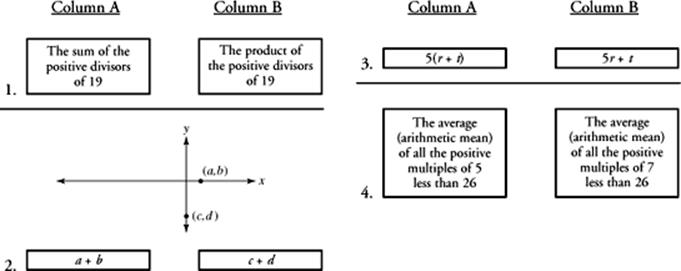
Directions: In the following questions, choose the best answer from the five choices listed.
5. If it is now June, what month will it be 400 months from now?
(A) January
(B) April
(C) June
(D) October
(E) December
6. What is the volume of a cube whose total surface area is 54?
(A) 9
(B) 27
(C) 54
(D) 81
(E) 729
7. If ![]() of the members of the school chorus are boys, what is the ratio of girls to boys in the chorus?
of the members of the school chorus are boys, what is the ratio of girls to boys in the chorus?
· (A) ![]()
· (B) ![]()
· (C) ![]()
· (D) ![]()
· (E) It cannot be determined from the information given.
|
Column A |
Column B |
|
|
8. |
(a + b)(a – b) |
a(b + a) – b(a + b) |
|
Dalia put exactly 75 cents worth of postage |
||
|
9. |
The number of 5-cent stamps she used |
The number of 7-cent stamps she used |
10. If A is 25 kilometers east of B, which is 12 kilometers south of C, which is 9 kilometers west of D, how far is it, in kilometers, from A to D?
(A) 20
(B) ![]()
(C) ![]()
(D) ![]()
(E) 71
|
Column A |
Column B |
|
|
A wooden cube whose edges |
||
|
11. |
The number of small cubes that have exactly three red faces |
The number of small cubes that have no red faces |

|
A number is a palindrome if it reads exactly |
||
|
13. |
The probability |
|
Questions 14 and 15 refer to the following graphs.
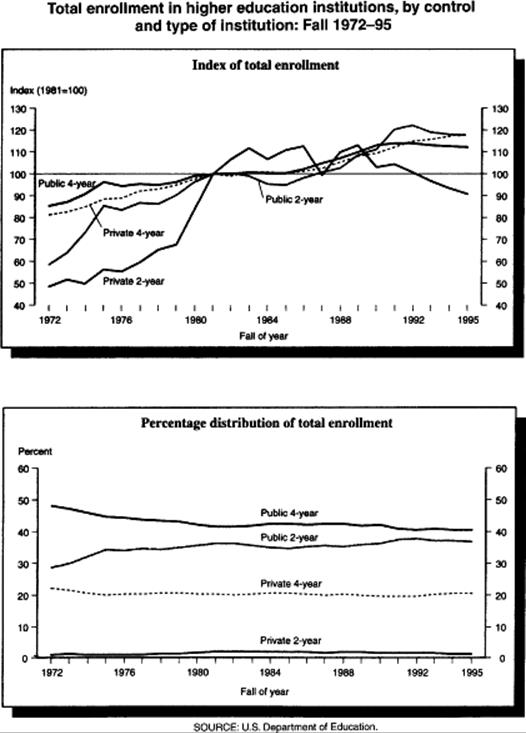
14. In 1995 the number of students enrolled in public institutions of higher education was approximately how many times the number of students enrolled in private institutions of higher education?
(A) 2 (B) 2.5 (C) 3 (D) 3.5 (E) 4
15. If the total enrollment in institutions of higher education in 1972 was 5,000,000, approximately how many students were enrolled in private 4-year institutions in 1995?
(A) 1,000,000
(B) 1,100,000
(C) 1,250,000
(D) 1,500,000
(E) 1,650,000
|
Column B |
Column A |
|
|
Jack and Jill each bought the same TV set |
||
|
16. |
The amount Jack paid |
The amount Jill paid |
|
|
||
|
In the multiplication problem above, |
||
|
17. |
B |
5 |
18. If the lengths of two of the sides of a triangle are 9 and 10, which of the following could be the length of the third side?
I. 1
II. 11
III. 21
(A) None
(B) I only
(C) II only
(D) I and II only
(E) I, II, and III
19. If x is a positive integer, which of the following CANNOT be an integer?
Questions 20 and 21 refer to the following graphs.
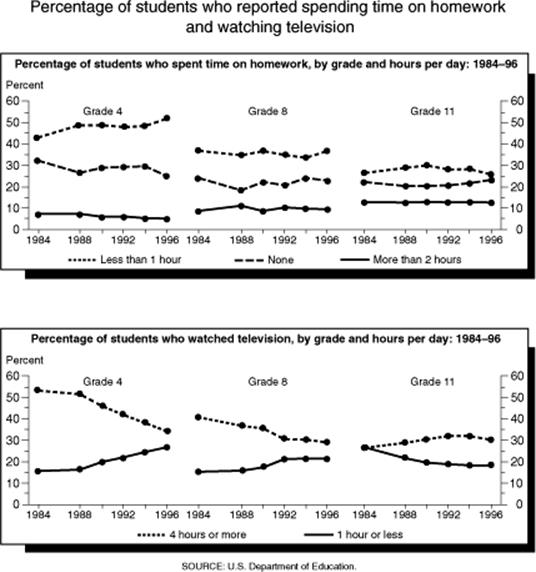
20. In 1996, what percent of fourth-graders did between 1 and 2 hours of homework per day?
(A) 5%
(B) 15%
(C) 25%
(D) 40%
(E) 55%
21. If in 1984 there were 2,000,000 eleventh-graders, and if between 1984 and 1996 the number of eleventh-graders increased by 10%, then approximately how many more eleventh-graders watched 1 hour or less of television in 1996 than in 1984?
(A) 25,000 (B) 50,000 (C) 75,000
(D) 100,000 (E) 150,000
22. Which of the following expresses the area of a circle in terms of C, its circumference?
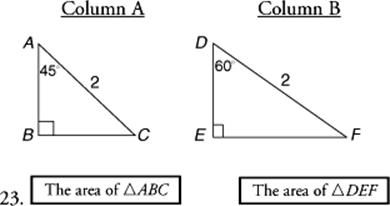
|
A is the sum of the integers from 1 to 50, and |
||
|
24. |
B − A |
2500 |
|
|
|
Each small circle has radius r, |
|
|
26. If p pencils cost c cents at the same rate, how many pencils can be bought for d dollars?
27. Because her test turned out to be more difficult than she intended it to be, a teacher decided to adjust the grades by deducting only half the number of points a student missed. For example, if a student missed 10 points, she received a 95 instead of a 90. Before the grades were adjusted the class average was A. What was the average after the adjustment?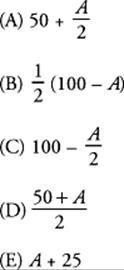
28. If a square and an equilateral triangle have equal perimeters, what is the ratio of the area of the triangle to the area of the square?
(E) It cannot be determined from the information given.
Section 3 Analytical Writing
TIME: 75 MINUTES—2 WRITING TASKS
Task 1: Issue Exploration
45 Minutes
Directions: In 45 minutes, choose one of the two following topics and compose an essay on that topic. You may not write on any other topic. Write your essay on separate sheets of paper.
Each topic is presented in a one- to two-sentence quotation commenting on an issue of general concern. Your essay may support, refute, or qualify the views expressed in the quotation. Whatever you write, however, must be relevant to the issue under discussion, and you must support your viewpoint with reasons and examples derived from your studies and/or experience.
Before you choose a topic, read both topics carefully. Consider which topic would give you greater scope for writing an effective, well-argued essay.
Faculty members from various institutions will evaluate your essay, judging it on the basis of your skill in the following areas.
• Analysis of the quotation’s implications
• Organization and articulation of your ideas
• Use of relevant examples and arguments to support your case
• Handling of the mechanics of standard written English
Once you have decided which topic you prefer, click on the appropriate icon (Topic 1 or Topic 2) to confirm your choice. Do not be hasty confirming your choice of topic. Once you have clicked on a topic, you will not be able to switch to the alternate choice.
Topic 1
“Young people frequently fall into the trap of assuming that the difficulties they face today are greater and more troublesome than those faced by previous generations. As they gain experience and maturity, however, they eventually become aware of the falsity of this assumption.”
Topic 2
“Question authority. Only by questioning accepted wisdom can we advance our understanding of the world.”
Task 2: Argument Analysis
30 MINUTES
Directions: In 30 minutes, prepare a critical analysis of an argument expressed in a short paragraph. You may not offer an analysis of any other argument. Write your essay on separate sheets of paper.
As you critique the argument, think about the author’s underlying assumptions. Ask yourself whether any of them are questionable. Also evaluate any evidence the author brings up. Ask yourself whether it actually supports the author’s conclusion.
In your analysis, you may suggest additional kinds of evidence to reinforce the author’s argument. You may also suggest methods to refute the argument, or additional data that might be useful to you as you assess the soundness of the argument. You may not, however, present your personal views on the topic. Your job is to analyze the elements of an argument, not to support or contradict that argument.
Faculty members from various institutions will judge your essay, assessing it on the basis of your skill in the following areas:
• Identification and assessment of the argument’s main elements
• Organization and articulation of your thoughts
• Use of relevant examples and arguments to support your case
• Handling of the mechanics of standard written English
The following appeared in a petition presented by Classen University students to the school’s administration.
The purpose of higher education is to prepare students for the future, but Classen students are at a serious disadvantage in the competition for post-college employment due to the University’s burdensome breadth requirements. Classen’s job placement rate is substantially lower than placement rates of many top-ranked schools. Classen students would be more attractive to employers if they had more time to take advanced courses in their specialty, rather than being required to spend fifteen percent of their time at Classen taking courses outside of their subject area. We demand, therefore, that the University abandon or drastically cut back on its breadth requirements.
Model Test 1
ANSWER KEY
Section I—Verbal Ability

Section 2—Quantitative Ability
Note: The letters in brackets following the Quantitative Ability answers refer to the sections of Chapter 14 in which you can find the information you need to answer the questions. For example, 1. C [E] means that the answer to question 1 is C, and that the solution requires information found in Section 14-E: Averages. Also, 20. A [13] means that the answer to question 20 is based on information in Chapter 13: Data Interpretation.

Section 3—Analytical Writing
There are no “correct answers” to this section.
Answer Explanations
Section 1—Verbal Ability
1. (A) The opposite of to estrange or to alienate is to reconcile.
Think of “estranged couples” in a divorce.
2. (B) The opposite of provident or frugal is prodigal or extravagant.
Think of the fable of the prodigal grasshopper and the provident ant.
3. (B) The author concedes that the big-bang theory has been changed somewhat: it has undergone refinement or polishing. However, he denies that its validity has been threatened seriously by any rival theories: it has resisted or defied all challenges.
The use of the support signal and indicates that the first missing word is similar in meaning to “modification.” The use of the contrast signal but indicates that the second missing word is contrary in meaning to “undergone modification.”
4. (E) One would have to disentangle a skein or coiled and twisted bundle of yarn.
Note how the presence of the verb disentangle, which may be used both figuratively and literally, influences the writer’s choice of words. In this case, while line and strand are possible choices, neither word possesses the connotations of twistings and tangled contortions that make skein the most suitable choice.
5. (C) A song is part of a cycle or series of songs. A sonnet is part of a sequence or series of sonnets. (Group and Member)
6. (E) Someone obdurate (unyielding, inflexible) is lacking in flexibility. Someone adamant (unshakable in opposition) is lacking in submissiveness. (Antonym Variant)
7. (C) The author says that the tendency for a government to encroach upon individual liberty to the extent to which it has the power to do so is “almost a natural law” of politics. Thus, government and individual liberty are inherently by their very natures in opposition to one another.
8. (C) If the fascist dictatorships “are the first truly tyrannical governments which western Europe has known for centuries,” then it can be inferred that centuries ago there were tyrannical or despotic governments in western Europe. Thus, the fascist governments represent a regression or reversion to an earlier form of government.
9. (B) Speech that is hybrid (made up of several elements) by definition combines these elements. The technical term hybrid best suits this context because it is a neutral term devoid of negative connotations (which motley and mangled possess).
10. (D) A man too wedded to orthodox theories or doctrines can best be described as doctrinaire or dogmatic.
11. (D) The opposite of to capitulate or yield is to resist.
Think of “capitulating without a fight.”
12. (C) The opposite of indigenous or native is alien or foreign.
Beware eye-catchers. Choice A is incorrect. Do not confuse indigenous or native with indigent or poor.
13. (B) To scurry is to move in a brisk and rapid manner. To chatter is to talk in a brisk and rapid manner. (Manner)
14. (B) A chameleon, a kind of lizard, is studied by a herpetologist (scientist who studies reptiles and amphibians). A salmon, a kind of fish, is studied by an ichthyologist.
(Defining Characteristic)
15. (B) The writer neither lists (enumerates) nor sorts (classifies) anything in the opening paragraph.
Choice A is incorrect. The writer likens the female tradition to a lost continent and develops the metaphor by describing the continent “rising … from the sea of English literature.”
Choice C is incorrect. The author refers or alludes to the classical legend of Atlantis.
Choice D is incorrect. The author quotes Colby and Thompson.
Choice E is incorrect. The author contrasts the revised view of women’s literature with Mill’s view.
16. (B) Moers states that the women’s literary movement produced “some of the greatest literary works of two centuries, as well as most of the lucrative pot-boilers.” Pot-boilers (inferior works of art produced chiefly for profit) by definition are not great works of art. Therefore, women’s literature was diverse in quality: it ranged from great to inferior.
Choice A is incorrect. While Moers states that women’s literature was not subordinate or inferior to mainstream literature, she never indicates that it was superior to mainstream literature.
Choice C is incorrect. Moers emphasizes that the women’s literary movement was multinational in character; she does not portray this international movement as parochial (very limited in outlook or scope; insular) in attitude.
Choice D is incorrect. Moers states that the women’s literary movement produced “most of the lucrative pot-boilers” of two centuries. Lucrative means profitable. Moers clearly portrays women’s literature as profitable rather than unprofitable.
Choice E is incorrect. Moers asserts that the women’s literary movement produced “some of the greatest literary works of two centuries.” In doing so, she portrays women’s literature as far from negligible or insignificant.
17. (D) The author opens the paragraph by stating that many literary critics have begun reinterpreting the study of women’s literature. She then goes on to cite individual comments that support her assertion. Clearly, she is receptive or open to the ideas of these writers, for they and she share a common sense of the need to reinterpret their common field.
Choices A and B are incorrect. The author cites the literary critics straightforwardly, presenting their statements as evidence supporting her thesis.
Choice C is incorrect. The author does not disparage or belittle these critics. By quoting them respectfully she implicitly acknowledges their competence.
Choice E is incorrect. The author quotes the critics as acknowledged experts in the field. However, she is objective in her approach; she does not look on these critics with awe (an overwhelming feeling of reverence).
18. (E) Question E is answerable on the basis of the passage. According to lines 8–10, Mill disbelieved in the idea that women “have had a literature of their own all along.”
19. (E) The opposite of to chagrin (disappoint) is to please.
Beware eye-catchers. Choice A is incorrect. Chagrin is unrelated to grin.
Think of “being chagrined by a defeat.”
20. (A) The opposite of disingenuous or guileful (giving a false impression of naiveté) is naive or unsophisticated.
Think of a “disingenuous appearance of candor.”
21. (C) Charlatan is another term for a quack or pretender to medical knowledge.
22. (E) The statement that “we do not know” whether a gesture indicates devotion or despair suggests that gestures are by their nature ambiguous or unclear.
23. (C) By definition, an ascetic (one who practices severe self-discipline) is characterized by self-denial. A zealot (extreme enthusiast) is characterized by fanaticism.
Beware eye-catchers. A miser may hoard wealth, but he is not necessarily characterized by affluence. Even poor persons may be misers. (Defining Characteristic)
24. (A) To camouflage something is to make it difficult to discern or perceive. To encipher or encode something is to make it difficult to comprehend. (Function)
25. (B) A seer or prophet is by definition someone gifted in prophecy. A sage or wise person is by definition someone gifted in wisdom. (Defining Characteristic)
26. (D) The author provides them as examples of what he means by the “fanciful … terminology” or idiosyncratic nomenclature in modern particle physics.
27. (D) Since the author considers the gluon to be aptly named, he clearly views this particular neologism or newly coined term with approbation. However, he tempers his approval with amusement, for he finds the terms fanciful (capricious, whimsical) as well as apt.
28. (D) The opposite of spurious (false or fraudulent) is genuine.
Think of forgers selling “a spurious work of art.”
29. (B) The opposite of tantamount or equivalent in value is not equivalent.
Context Clue: “Failure to publish is tantamount to suppression.”
30. (D) The incongruity here is that one group finds Woolf too feminine for their tastes while another finds her not feminine (or perhaps feminist) enough for theirs.
Note that the word peculiar signals that Woolf’s destiny is an unexpected one.
Section 2 — Quantitative Ability
Two asterisks (**) indicate an alternative method of solving.
1. (A) The only positive divisors of 19 are 1 and 19.
Column A: 1 + 19 = 20.
Column B: 1 × 19 = 19.
2. (A) Since (a, b) is on the positive portion of the x-axis, a is positive and b = 0; so a + b is positive. Also, since (c, d) is on the negative portion of the y-axis, c is negative and d = 0; so c + d is negative. Column A is greater.
3. (D) By the distributive law, Column A is 5r + 5t. Subtract 5r from each column, and compare 5t and t. They are equal if t = 0 and unequal otherwise. Neither column is always greater, and the two columns are not always equal (D).
4. (A) Column A: there are 5 positive multiples of 5 less than 26: 5, 10, 15, 20, 25; their average is 15, the middle one [KEY FACT E5].
Column B: there are 3 positive multiples of 7 less than 26: 7, 14, 21; their average is 14.
Column A is greater.
5. (D) Since 400 = 12 × 33 + 4, 100 months is 4 months more than 33 years. 33 years from June it will again be June, and 4 months later it will be October. [See Section 14-P]
**Look for a pattern. Since there are 12 months in a year, after every 12 months it will again be June; i.e., it will be June after 12, 24, 36, 48,…, 120,…, 360 months. So, 396 (33 × 12) months from now, it will again be June. Count 4 more months to October.
6. (B) Since the surface area of the cube is 54, the area of each of the six faces is a square. 54 ÷ 6 = 9. Since each face in a square is the same each edge is 3, and the volume is 33 = 27.
7. (B) Use TACTIC 3 in Chapter 11: pick an easy-to-use number. Since ![]() of the members are boys, assume there are 9 members, 5 of whom are boys. Then the other 4 are girls, and the ratio of girls to boys is 4 to 5, or
of the members are boys, assume there are 9 members, 5 of whom are boys. Then the other 4 are girls, and the ratio of girls to boys is 4 to 5, or ![]() .
.
8. (C) Column A: (a + b)(a − b) = a2 − b2.
Column B: a(b + a) − b(a + b) =
ab + a2 − ba – b2 = a2 − b2.
9. (D) If x and y represent the number of 5-cent stamps and 7-cent stamps, respectively, that Dalia used, then 5x + 7y = 75. There are infinitely many solutions to this equation, but there are only two solutions in which x and y are both positive integers: y = 10 and x = 1 or y = 5 and x = 8. Neither column is always greater, and the two columns are not always equal (D).
10. (A) Use TACTIC 1 in Chapter 10: draw a diagram. In the figure below, form rectangle BCDE by drawing DE ⊥ AB. Then, BE = 9, AE = 16, and DE = 12. Finally, DA = 20, because right triangle AED is a 3-4-5 triangle in which each side is multiplied by 4. If you don’t realize that, use the Pythagorean theorem to get DA: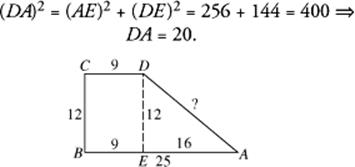
11. (C) Draw a diagram, and on each small cube write the number of red faces it has. The cubes with three red faces are the eight corners. The cubes with no red faces are the “inside” ones that can’t be seen. If you cut off the top and bottom rows, the front and back rows, and the left and right rows, you are left with a small 2-inch cube, none of whose faces is red. That 2-inch cube is made up of eight 1-inch cubes. The columns are equal (C).
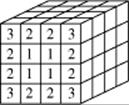
12. (B) Since ![]() , then
, then ![]() .
.
Therefore, d − c = cd, which is positive. Then, d − c is positive, and so d > c. Column B is greater.
13. (C) The simplest solution is to realize that there is one palindrome between 100 and 109 (101), one between 390 and 399 (393), one between 880 and 889 (888), and in general, one out of every 10 numbers. So the probability is ![]() . The answer is (C).
. The answer is (C).
**The more direct solution is to count the number of palindromes. Either systematically make a list and notice that there are 10 of them between 100 and 199, and 10 in each of the hundreds from the 100s to the 900s, for a total of 90; or use the counting principle: the first digit can be chosen in any of 9 ways, the second in any of 10 ways, and the third, since it must match the first, can be chosen in only 1 way (9 × 10 × 1 = 90). Since there are 900 three-digit numbers, the probability is ![]() .
.
14. (D) From the bottom graph, we can estimate the percentage distribution of total enrollment to be:
|
Public 4-year |
41% |
Private 4-year |
21% |
|
Public 2-year |
37% |
Private 2-year |
1% |
|
Total public |
78% |
Total private |
22% |
15. 78 ÷ 22 ≈ 3.5, so there were 3.5 times as many students enrolled in public institutions as private ones.
16. (E) In 1972, enrollment in private 4-year institutions was approximately 1,100,000 (22% of the total enrollment of 5,000,000). By 1995, the index for private 4-year institutions had increased from 80 to 120, a 50% increase. Therefore, the number of private 4-year students enrolled in 1995 was approximately 1,650,000 (50% more than the 1,100,000 students enrolled in 1972).
17. (C) Let P = the price of the TV set. Then Jack paid 1.085(.90P), whereas Jill paid .90(1.085P). The columns are equal (C).
**Use TACTIC 2, Chapter 12, and choose a convenient number: assume the TV cost $100. Jack paid $90 plus $7.65 tax (8.5% of $90) for a total of $97.65. Jill’s cashier rang up $100 plus $8.50 tax and then deducted $10.85 (10% of $108.50) for a final cost of $97.65.
18. (B) Since A times ABA is a three-digit number, A has to be less than 4; but 1 times ABA is ABA, so A ≠ 1. Therefore, A = 2 or A = 3.
Since there is no carrying, either 2 × B = C, a one-digit number, and B < 5, or 3 × B = C, and B < 3. In either case, column B is greater.
19. (C) By the triangle inequality (KEY FACTS J12 and J13),
• The third side must be less than 9 + 10 = 19. (III is false.)
• The third side must be greater than 10 – 9 = 1. (I is false.)
• Any number between 1 and 19 could be the length of the third side. (II is true.)
The answer is C.
20. (D) Check each choice. (A) If x = 5,![]() This one is more difficult; the only possibility if x = 1, in which case
This one is more difficult; the only possibility if x = 1, in which case ![]() . If you don’t see that immediately, keep Choice B under consideration, and test the rest. (C) If
. If you don’t see that immediately, keep Choice B under consideration, and test the rest. (C) If ![]() . (D) For positive x,
. (D) For positive x, ![]() is always greater than 1 but less than 2;
is always greater than 1 but less than 2; ![]() cannot be an integer—that’s it. If you didn’t reason that out, check Choice E.
cannot be an integer—that’s it. If you didn’t reason that out, check Choice E. ![]() . You should have eliminated at least Choices, A, C, and E.
. You should have eliminated at least Choices, A, C, and E.
21. (B) From the top graph, we see that among fourth-graders in 1996:
25% did no homework;
55% did less than 1 hour;
5% did more than 2 hours.
This accounts for 85% of the fourth-graders; the other 15% did between 1 and 2 hours of homework per day.
22. (E) In 1984, approximately 540,000 eleventh-graders watched television 1 hour or less per day (27% of 2,000,000). By 1996, the number of eleventh-graders had increased by 10% to 2,200,000, but the percent of them who watched television 1 hour or less per day decreased to about 18%: 18% of 2,200,000 is 396,000. This is a decrease of 144,000, or approximately 150,000.
23. (A) Since C = 2πr, then ![]() , and area of circle
, and area of circle ![]()
24. (A) Column A: Since the hypotenuse is 2, the length of each leg is ![]() , and the area is
, and the area is ![]() .
.
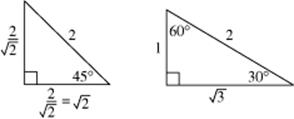
Column B: Since the hypotenuse is 2, the shorter leg is 1, the longer leg is ![]() , and the area is
, and the area is ![]() , which is less than 1 because
, which is less than 1 because ![]() is less than 2.
is less than 2.
Column A is greater.
25. (C) B − A =
(51+52+53+…+99+100) – (1+2+3+…+49+50)
= (51–1)+(52–2)+(53–3)+…+(99–49)+(100–50)
= 50 + 50 + 50 +…+ 50 + 50 = 50 × 50 = 2500.
**If you know the formula, ![]() ,for adding up the first n positive integers, you can use it:
,for adding up the first n positive integers, you can use it: ![]() . B is the sum of the integers from 1 to 100 minus the sum of the integers from 1 to 50:
. B is the sum of the integers from 1 to 100 minus the sum of the integers from 1 to 50:
Finally, B − A = 3875 – 1275 = 2500.
The columns are equal (C).
26. (A) Since the area of each small circle is πr2, the area of the white region is 3πr2. Also, since the area of the large circle is πR2, the shaded area is πR2 − 3πr2 = π(R2 − 3r2). Since the areas of the white region and the shaded region are equal:
which is greater than 2. Column A is greater.
27. (E) Since p pencils cost c cents, each pencil costs ![]() cents. By dividing the number of cents we have by
cents. By dividing the number of cents we have by ![]() , we find out how many pencils we can buy. Since d dollars equals 100d cents, we divide 100d by
, we find out how many pencils we can buy. Since d dollars equals 100d cents, we divide 100d by ![]() , which is equivalent to multiplying 100d by:
, which is equivalent to multiplying 100d by: ![]() .
.
You will probably prefer the alternate solution below.
**Use TACTIC 2, Chapter 12. Assume 2 pencils cost 10 cents. So, pencils cost 5 cents each or 20 for one dollar. So, for 3 dollars, we can buy 60 pencils. Which of the choices equals 60 when p = 2, c = 10, and d = 3? Only ![]() .
.
28. (A) If a student earned a grade of g, she missed (100 – g) points. In adjusting the grades, the teacher decided to deduct only half that number: ![]() . So the student’s new grade was
. So the student’s new grade was ![]() .
.
Since this was done to each student’s grade, the effect on the average was exactly the same. The new average was ![]() .
.
29. (A) Use TACTIC 3, Chapter 11. Choose an appropriate number for the common perimeter. Any number will work; but since a triangle has 3 sides and a square has 4 sides, 12 is a good choice. Then, each side of the square is 3, and the area is 32 = 9. Each side of the equilateral triangle is 4, and the area is ![]() (KEY FACT J15).
(KEY FACT J15).
The ratio is ![]() .
.
Section 3 — Analytical Writing
There are no “correct answers” to this section.
Answer Sheet
MODEL TEST 2
Section 1
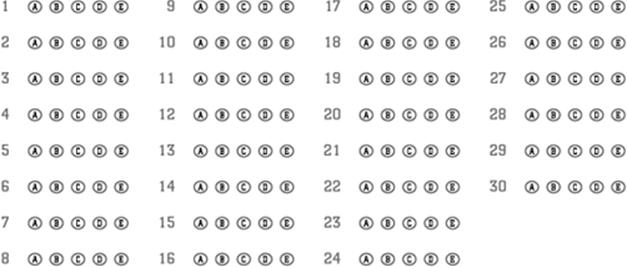
Section 2
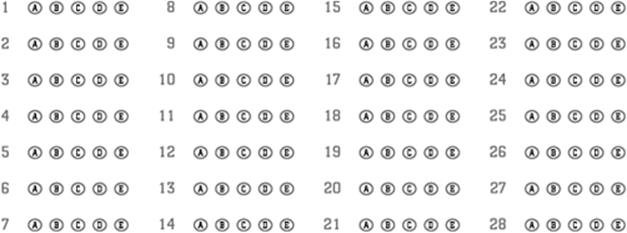
Model Test 2
Section 1 Verbal Ability
TIME: 30 MINUTES—30 QUESTIONS
Directions: In each of the following antonym questions, a word printed in capital letters precedes five lettered words or phrases. From these five lettered words or phrases, pick the one most nearly opposite in meaning to the capitalized word.
1. ELATED:
(A) crestfallen
(B) inebriated
(C) punctual
(D) insulted
(E) lamented
2. RETICENCE:
(A) irascibility
(B) loquaciousness
(C) quiescence
(D) patience
(E) surrender
Directions: Each of the following sentence completion questions contains one or two blanks. These blanks signify that a word or set of words has been left out. Below each sentence are five words or sets of words. For each blank, pick the word or set of words that best reflects the sentence’s overall meaning.
3. You may wonder how the expert on fossil remains is able to trace descent through teeth, which seem __________ pegs upon which to hang whole ancestries.
(A) novel
(B) reliable
(C) specious
(D) inadequate
(E) academic
4. An essential purpose of the criminal justice system is to enable purgation to take place; that is, to provide a __________ by which
a community expresses its collective __________ the transgression of the criminal.
(A) catharsis…outrage at
(B) disclaimer…forgiveness of
(C) means…empathy with
(D) procedure…distaste for
(E) document…disapprobation of
Directions: Each of the following analogy questions presents a related pair of words linked by a colon. Five lettered pairs of words follow the linked pair. Choose the lettered pair of words whose relationship is most like the relationship expressed in the original linked pair.
5. VINDICTIVE : MERCY ::
(A) avaricious : greed
(B) insightful : hope
(C) modest : dignity
(D) skeptical : trustfulness
(E) pathetic : sympathy
6. RUFFLE : COMPOSURE ::
(A) flounce : turmoil
(B) flourish : prosperity
(C) provoke : discussion
(D) adjust : balance
(E) upset : equilibrium
Directions: Each of the following reading comprehension questions is based on the content of the following passage. Read the passage and then determine the best answer choice for each question. Base your choice on what this passage states directly or implies, not on any information you may have gained elsewhere.
Reading Comprehension
Given the persistent and intransigent
nature of the American race system, which
proved quite impervious to black attacks,
Line Du Bois in his speeches and writings moved
(5) from one proposed solution to another, and
the salience of various parts of his philosophy
changed as his perceptions of the needs
and strategies of black America shifted over
time. Aloof and autonomous in his personality,
(10) Du Bois did not hesitate to depart
markedly from whatever was the current
mainstream of black thinking when he perceived
that the conventional wisdom being
enunciated by black spokesmen was proving
(15) inadequate to the task of advancing the race.
His willingness to seek different solutions
often placed him well in advance of his
contemporaries, and this, combined with a
strong-willed, even arrogant personality
(20) made his career as a black leader essentially
a series of stormy conflicts.
Thus Du Bois first achieved his role as a
major black leader in the controversy that
arose over the program of Booker T.
(25) Washington, the most prominent and influential
black leader at the opening of the
twentieth century. Amidst the wave of lynchings,
disfranchisement, and segregation laws,
Washington, seeking the good will of powerful
(30) whites, taught blacks not to protest
against discrimination, but to elevate themselves
through industrial education, hard
work, and property accumulation; then, they
would ultimately obtain recognition of their
(35) citizenship rights. At first Du Bois agreed with
this gradualist strategy, but in 1903 with
the publication of his most influential book,
Souls of Black Folk, he became the chief
leader of the onslaught against Washington
(40) that polarized the black community into two
wings—the “conservative” supporters of
Washington and his “radical” critics.
7. The author’s primary purpose in the passage is to
(A) explain how Du Bois was influenced by Washington
(B) compare the personalities of Du Bois and Washington
(C) explain why Du Bois gained power in the black community
(D) describe Du Bois’ role in early twentieth-century black leadership
(E) correct the misconception that Du Bois shunned polarization
8. Which of the following statements about W. E. B. Du Bois does the passage best support?
(A) He sacrificed the proven strategies of earlier black leaders to his craving for political novelty.
(B) Preferring conflict to harmony, he followed a disruptive course that alienated him from the bulk of his followers.
(C) He proved unable to change with the times in mounting fresh attacks against white racism.
(D) He relied on the fundamental benevolence of the white population for the eventual success of his movement.
(E) Once an adherent of Washington’s policies, he ultimately lost patience with them for their inefficacy.
9. It can be inferred that Booker T. Washington in comparison with W. E. B. Du Bois could be described as all of the following EXCEPT
(A) submissive to the majority
(B) concerned with financial success
(C) versatile in adopting strategies
(D) traditional in preaching industry
(E) respectful of authority
10. The author’s attitude toward Du Bois’ departure from conventional black policies can best be described as
(A) skeptical
(B) derisive
(C) shocked
(D) approving
(E) resigned
Antonyms
11. REVILE:
(A) compose
(B) awake
(C) deaden
(D) praise
(E) secrete
12. PROPITIOUS:
(A) adjacent
(B) clandestine
(C) contentious
(D) unfavorable
(E) coy
Analogies
13. OFFHAND : PREMEDITATION ::
(A) upright : integrity
(B) aboveboard : guile
(C) cutthroat : competition
(D) backward : direction
(E) underlying : foundation
14. LARVAL : INSECT ::
(A) serpentine : snake
(B) floral : plant
(C) amphibian : reptile
(D) embryonic : mammal
(E) alate : bird
Sentence Completion
15. When facts are __________ and data hard to come by, even scientists occasionally throw aside the professional pretense of __________ and tear into each other with shameless appeals to authority and arguments that are unabashedly ad hominem.
(A) elusive…objectivity
(B) established…courtesy
(C) demonstrable…neutrality
(D) ineluctable…cooperation
(E) hypothetical…scholarship
16. In the tradition of scholarly __________, the poet and scholar A.E. Housman once assailed a German rival for relying on manuscripts “as a drunkard relies on lampposts, for __________ rather than illumination.”
(A) animosity…current
(B) discourse…stability
(C) erudition…shadow
(D) invective…support
(E) competition…assistance
Reading Comprehension
At night, schools of prey and predators are
almost always spectacularly illuminated by
the bioluminescence produced by the microscopic
Line and larger plankton. The reason for
(5) the ubiquitous production of light by the
microorganisms of the sea remains obscure,
and suggested explanations are controversial.
It has been suggested that light is a kind of
inadvertent by-product of life in transparent
(10) organisms. It has also been hypothesized that
the emission of light on disturbance is
advantageous to the plankton in making the
predators of the plankton conspicuous to
their predators! Unquestionably, it does act
(15) this way. Indeed, some fisheries base the
detection of their prey on the bioluminescence
that the fish excite. It is difficult, however,
to defend the thesis that this effect was
the direct factor in the original development
(20) of bioluminescence, since the effect was of
no advantage to the individual microorganism
that first developed it. Perhaps the luminescence
of a microorganism also discourages
attack by light-avoiding predators and is of
(25) initial survival benefit to the individual.
As it then becomes general in the population,
the effect of revealing plankton predators
to their predators would also become
important.
17. The primary topic of the passage is which of the following?
(A) The origin of bioluminescence in plankton predators
(B) The disadvantages of bioluminescence in microorganisms
(C) The varieties of marine bioluminescent life forms
(D) Symbiotic relationships between predators and their prey
(E) Hypotheses on the causes of bioluminescence in plankton
18. The author mentions the activities of fisheries in order to provide an example of
(A) how ubiquitous the phenomenon of bioluminescence is coastally
(B) how predators do make use of bioluminescence in locating their prey
(C) how human intervention imperils bioluminescent microorganisms
(D) how nocturnal fishing expeditions are becoming more and more widespread
(E) how limited bioluminescence is as a source of light for human use
Antonyms
19. INCONGRUOUS:
(A) external
(B) prudent
(C) legitimate
(D) harmonious
(E) efficacious
20. APOSTATE:
(A) laggard
(B) loyalist
(C) martinet
(D) predecessor
(E) skeptic
Analogies
21. SEXTANT : NAUTICAL ::
(A) octet : musical
(B) therapy : physical
(C) forceps : surgical
(D) comet : astronomical
(E) blueprint : mechanical
22. REFRACTORY : MANAGE ::
(A) redoubtable : impress
(B) lethargic : stimulate
(C) pedantic : convince
(D) officious : arrange
(E) aggrieved : distress
Antonyms
23. ENSUE:
(A) litigate
(B) precede
(C) arbitrate
(D) accentuate
(E) delay
Sentence Completion
24. While the disease is in __________ state it is almost impossible to determine its existence by __________.
(A) a dormant…postulate
(B) a critical…examination
(C) an acute…analysis
(D) a suspended…estimate
(E) a latent…observation
25. Virginia Woolf __________ conventional notions of truth: in her words, one cannot receive from any lecture “a nugget of pure truth” to wrap up between the pages of one’s notebook and keep on the mantelpiece forever.
(A) anticipates
(B) articulates
(C) neglects
(D) mocks
(E) rationalizes
Reading Comprehension
The curtain rises; the Cardinal and Daniel
de Bosola enter from the right. In appearance,
the Cardinal is something between an
Line El Greco cardinal and a Van Dyke noble
(5) lord. He has the tall, spare form—the elongated
hands and features—of the former;
the trim pointed beard, the imperial repose,
the commanding authority of the latter. But
the El Greco features are not really those of
(10) asceticism or inner mystic spirituality. They
are the index to a cold, refined but ruthless
cruelty in a highly civilized controlled form.
Neither is the imperial repose an aloof mood
of proud detachment. It is a refined expression
(15) of satanic pride of place and talent.
To a degree, the Cardinal’s coldness is artificially
cultivated. He has defined himself
against his younger brother Duke Ferdinand
and is the opposite to the overwrought emotionality
(20) of the latter. But the Cardinal’s
aloof mood is not one of bland detachment.
It is the deliberate detachment of a methodical
man who collects his thoughts and emotions
into the most compact and formidable
(25) shape—that when he strikes, he may strike
with the more efficient and devastating force.
His easy movements are those of the slowly
circling eagle just before the swift descent
with the exposed talons. Above all else, he is
(30) a man who never for a moment doubts his
destined authority as a governor.
26. In lines 27–29 the author most likely compares the movements of the Cardinal to those of a circling eagle in order to emphasize his
(A) flightiness
(B) love of freedom
(C) eminence
(D) sense of spirituality
(E) mercilessness
27. Which of the following best characterizes the author’s attitude toward the Cardinal?
(A) He deprecates his inability to sustain warm familial relationships.
(B) He esteems him for his spiritual and emotional control.
(C) He admires his grace in movement and sure sense of personal authority.
(D) He finds him formidable both as an opponent and as a dramatic character.
(E) He is perturbed by his inconsistencies in behavior.
Analogies
28. AUSTERE : STYLE ::
(A) controlled : movement
(B) affluent : wealth
(C) subservient : demeanor
(D) inspirational : faith
(E) pragmatic : speech
Antonyms
29. RETROSPECTION:
(A) introversion
(B) deliberation
(C) anticipation
(D) gregariousness
(E) equivocation
30. TOPICAL:
(A) general
(B) disinterested
(C) chronological
(D) fallacious
(E) imperceptible
Section 2 Quantitative Ability
Time: 45 Minutes—28 Questions
Directions: In the following type of question, two quantities appear, one in Column A and one in Column B. You must compare them. The correct answer to the question is
A if the quantity in Column A is greater
B if the quantity in Column B is greater
C if the two quantities are equal
D if it is impossible to determine which quantity is greater
Notes: Sometimes information about one or both of the quantities is centered above the two columns. If the same symbol appears in both columns, it represents the same thing each time.

Directions: In the following questions, choose the best answer from the five choices listed.
5. The Center City Little League is divided into d divisions. Each division has t teams, and each team has p players. How many players are there in the entire league?
(A) d + t + p
(B) dtp
(C) ![]()
(D) ![]()
(E) ![]()
6. A number x is chosen at random from the set of positive integers less than 10. What is the probability that ![]() ?
?
(A) ![]()
(B) ![]()
(C) ![]()
(D) ![]()
(E) ![]()
7. If ![]() then a =
then a =
(A) ![]()
(B) ![]()
(C) ![]()
(D) 3
(E) 4
|
Column A |
Column B |
|
|
|
||
8. ![]()
|
a+b=24 |
||
|
9. |
b |
0 |
10. In 1980, the cost of p pounds of potatoes was d dollars. In 1990, the cost of 2p pounds of potatoes was ![]() d dollars. By what percent did the price of potatoes decrease from 1980 to 1990?
d dollars. By what percent did the price of potatoes decrease from 1980 to 1990?
(A) 25%
(B) 50%
(C) 75%
(D) 100%
(E) 400%
|
Column A |
Column B |
|
|
a+2b=6d |
||
11. 
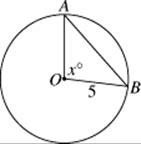
90<x
12. ![]()
![]()
13. 
Questions 14 and 15 refer to the graph on page 579.
14. If family A has an income of $95,000 per year, and family B has an income of $35,000 per year, and each has a child attending a 4-year public university, to the nearest $1000, how much more would family A be expected to pay than family B?
(A) $4000
(B) $7000
(C) $10,000
(D) $12,000
(E) $15,000
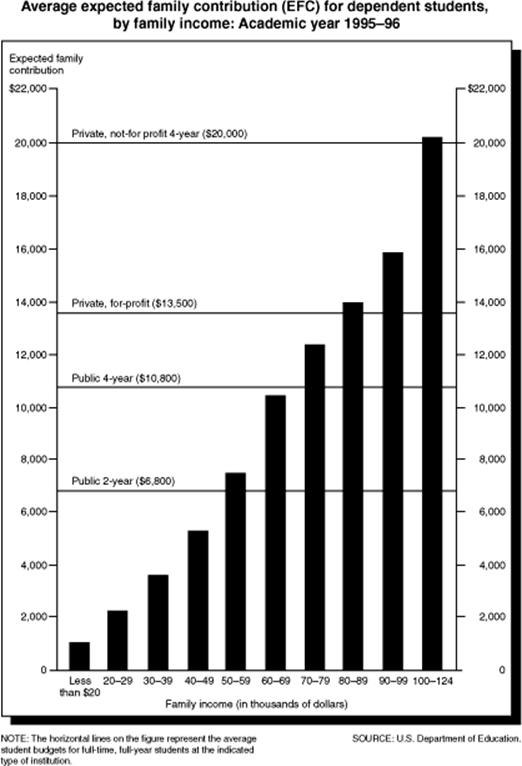
15. A family’s unmet need (which must be covered by a financial aid package) is defined to be the total cost of attending an institution of higher education minus the expected family contribution. What is the unmet need of a family whose income is $55,000 and who has a child attending a 4-year public university?
(A) $700
(B) $3300
(C) $6800
(D) $7500
(E) $12,500
|
Column A |
Column B |
16. ![]()
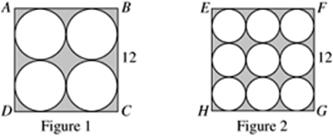
ABCD and EFGH are squares, and all the circles are tangent to one another and to the sides of the squares.
17. 
18. A bag contains 3 red, 4 white, and 5 blue marbles. Jason begins removing marbles from the bag at random, one at a time. What is the least number of marbles he must remove to be sure that he has at least one of each color?
(A) 3 (B) 6 (C) 8 (D) 10 (E) 12
19. Jordan has taken 5 math tests so far this semester. If he gets a 70 on his next test, it will lower the average (arithmetic mean) of his test scores by 4 points. What is his average now?
(A) 74 (B) 85 (C) 86 (D) 90 (E) 94
Questions 20 and 21 refer to the following graphs.
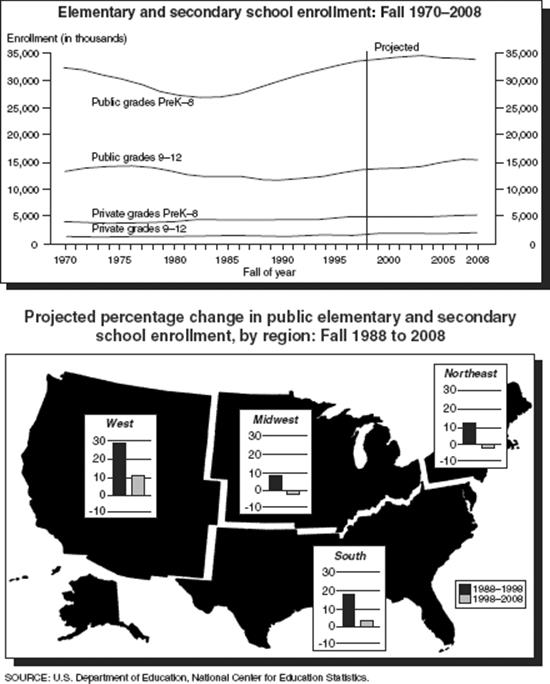
20. To the nearest million, how many more students were enrolled in school—both public and private, preK–12—in 1970 than in 1988?
(A) 3,000,000
(B) 6,000,000
(C) 10,000,000
(D) 44,000,000
(E) 51,000,000
21. In 1988 there were 40,000,000 public school students in the United States, of whom 22% lived in the West. Approximately, how many public school students are projected to be living in the West in 2008?
(A) 9,000,000
(B) 12,000,000
(C) 15,000,000
(D) 24,000,000
(E) 66,000,000
22. If a and b are the lengths of the legs of a right triangle whose hypotenuse is 10 and whose area is 20, what is the value of (a + b)2?
(A) 100
(B) 120
(C) 140
(D) 180
(E) 200
|
Column A |
Column B |
||
|
The circumference of a circle is aπ inches. |
|||
|
23. |
a |
b |
|
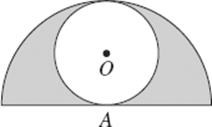
The circle with center O is inscribed in the semicircle with center A.
24. 
A school group charters three identical buses and occupies ![]() of the seats. After
of the seats. After ![]() of the passengers leave, the remaining passengers use only two of the buses.
of the passengers leave, the remaining passengers use only two of the buses.
25. 
26. What is the average (arithmetic mean) of 330, 360, and 390?
(A) 360
(B) 3177
(C) 310 + 320 + 330
(D) 327 + 357 + 387
(E) 329 + 359 + 389
27. The figure below consists of four semicircles in a large semicircle. If the small semicircles have radii of 1, 2, 3, and 4, what is the perimeter of the shaded region?

(A) 10π
(B) 20π
(C) 40π
(D) 60π
(E) 100π
28. If a is increased by 25% and b is decreased by 25%, the resulting numbers will be equal. What is the ratio of a to b?
(A) ![]()
(B) ![]()
(C) ![]()
(D) ![]()
(E) ![]()
Section 3 Analytical Writing
TIME: 75 MINUTES—2 WRITING TASKS
Task 1: Issue Exploration
45 MINUTES
Directions: In 45 minutes, choose one of the two following topics and compose an essay on that topic. You may not write on any other topic. Write your essay on separate sheets of paper.
Each topic is presented in a one- to two-sentence quotation commenting on an issue of general concern. Your essay may support, refute, or qualify the views expressed in the quotation. Whatever you write, however, must be relevant to the issue under discussion, and you must support your viewpoint with reasons and examples derived from your studies and/or experience.
Before you choose a topic, read both topics carefully. Consider which topic would give you greater scope for writing an effective, well-argued essay.
Faculty members from various institutions will evaluate your essay, judging it on the basis of your skill in the following areas.
• Analysis of the quotation’s implications
• Organization and articulation of your ideas
• Use of relevant examples and arguments to support your case
• Handling of the mechanics of standard written English
Once you have decided which topic you prefer, click on the appropriate icon (Topic 1 or Topic 2) to confirm your choice. Do not be hasty confirming your choice of topic. Once you have clicked on a topic, you will not be able to switch to the alternate choice.
Topic 1
“If rituals did not exist, we would have to invent them. We need ceremonies and rituals to help us define ourselves socially and culturally.”
Topic 2
“In this electronic age, reading has inevitably taken a back seat to watching television and gleaning information from the World Wide Web. People learn far more readily from electronic media than they do from print.”
Task 2: Argument Analysis
30 MINUTES
Directions: In 30 minutes, prepare a critical analysis of an argument expressed in a short paragraph. You may not offer an analysis of any other argument. Write your essay on separate sheets of paper.
As you critique the argument, think about the author’s underlying assumptions. Ask yourself whether any of them are questionable. Also evaluate any evidence the author brings up. Ask yourself whether it actually supports the author’s conclusion.
In your analysis, you may suggest additional kinds of evidence to reinforce the author’s argument. You may also suggest methods to refute the argument, or additional data that might be useful to you as you assess the soundness of the argument. You may not, however, present your personal views on the topic. Your job is to analyze the elements of an argument, not to support or contradict that argument.
Faculty members from various institutions will judge your essay, assessing it on the basis of your skill in the following areas:
• Identification and assessment of the argument’s main elements
• Organization and articulation of your thoughts
• Use of relevant examples and arguments to support your case
• Handling of the mechanics of standard written English
The following appeared in a letter to the editor in the journal Health Matters.
Statistics gathered over the past three decades show that the death rate is higher among those who do not have jobs than among those with regular employment. Unemployment, just like heart disease and cancer, is a significant health issue. While many health care advocates promote increased government funding for medical research and public health care, it would be folly to increase government spending if doing so were to affect the nation’s economy adversely and ultimately cause a rise in unemployment. A healthy economy means healthy citizens.
Model Test 2
ANSWER KEY
Section I—Verbal Ability

Section 2—Quantitative Ability
Note: The letters in brackets following the Quantitative Ability answers refer to the sections of Chapter 14 in which you can find the information you need to answer the questions. For example, 1. C [E] means that the answer to question 1 is C, and that the solution requires information found in Section 14-E: Averages. Also, 20. A [13] means that the answer to question 20 is based on information in Chapter 13: Data Interpretation.

Section 3—Analytical Writing
There are no “correct answers” to this section.
ANSWER EXPLANATIONS
Section 1—Verbal Ability
1. (A) Elated (joyful, in high spirits) is the opposite of crestfallen (dejected).
Think of “elated by her success.”
2. (B) The opposite of reticence (uncommunicativeness; restraint in speech) is loquaciousness (talkativeness).
Think of “speaking without reticence.”
3. (D) If “you may wonder” how the expert reaches his conclusions, it appears that it is questionable to rely on teeth for guidance in interpreting fossils. Choice D, inadequate, creates the element of doubt that the clause tries to develop. Choice C, specious, also creates an element of doubt; however, nothing in the context justifies the idea that the reasoning is specious or false.
Note that here you are dealing with an extended metaphor. Picture yourself hanging a heavy winter coat on a slim wooden peg. Wouldn’t you worry that the peg might prove inadequate or flimsy?
4. (A) Here the task is to determine the communal reaction to crime. The writer maintains that the criminal justice system of punishments allows the community to purge itself of its anger, its sense of outrage at the criminal’s acts. Thus, it provides a catharsis or purgation for the community.
Remember, in double-blank sentences, go through the answers, testing the first word in each choice and eliminating those that don’t fit. In this case, you can readily eliminate Choices B and E: it is unlikely that an essentialpurpose of the criminal justice system would be the provision of either a disclaimer (denial or disavowal, as in disavowing responsibility for a legal claim) or a document.
5. (D) Someone vindictive or vengeful is lacking in mercy. Someone skeptical or suspicious is lacking in trustfulness. (Antonym Variant)
6. (E) To ruffle someone’s composure is to disturb or trouble his self-possession. To upset someone’s equilibrium is to disturb or trouble his balance. (Function)
7. (D) The author first discusses Du Bois in relationship to black leaders in general and then provides the specific example of his relationship to Booker T. Washington.
Choice A is incorrect. The author mentions Du Bois’ early support of Washington’s gradualist approach in order to contrast it with his later departure from Washington’s conservatism.
Choice B is incorrect. The author discusses Du Bois’ personality only in passing; he does not discuss Washington’s personality at all.
Choice C is incorrect. The author’s chief concern is to describe Du Bois’ position as a major black leader, not to analyze what lay behind his achieving this position.
Choice E is incorrect. Although the author states that Du Bois became the chief leader of the forces opposing Washington and thus was involved in the polarization of the black community, the author’s primary purpose is not to correct a misconception that Du Bois shunned polarization.
8. (E) The last sentence points out that Du Bois originally agreed with Washington’s program.
Choice A is incorrect. Nothing in the passage suggests that Du Bois sacrificed effective strategies out of a desire to try something new.
Choice B is incorrect. Du Bois gained in influence, effectively winning away large numbers of blacks from Washington’s policies.
Choice C is incorrect. Du Bois’ quickness to depart from conventional black wisdom when it proved inadequate to the task of advancing the race shows him to be well able to change with the times.
Choice D is incorrect. Washington, not Du Bois, is described as seeking the good will of powerful whites.
9. (C) The author does not portray Washington as versatile. Instead, he portrays Du Bois as versatile.
Choice A is incorrect. The author portrays Washington as submissive to the majority; he shows him teaching blacks not to protest.
Choice B is incorrect. The author portrays Washington as concerned with financial success; he shows him advocating property accumulation.
Choice D is incorrect. The author portrays Washington as traditional in preaching industry; he shows him advocating hard work.
Choice E is incorrect. The author portrays Washington as respectful of authority; he shows him deferring to powerful whites.
10. (D) Although the author points out that Du Bois’ methods led him into conflicts, he describes Du Bois as “often…well in advance of his contemporaries” and stresses that his motives for departing from the mainstream were admirable. Thus, his attitude can best be described as approving.
11. (D) To revile (verbally abuse) something is the opposite of praising it.
Think of “reviled as a traitor.”
12. (D) The opposite of propitious (favorable, advantageous) is unfavorable.
Think of being pleased by “propitious omens.”
13. (B) An offhand remark is made without forethought or premeditation. An aboveboard (open) deed is done without trickery or guile. (Antonym Variant)
14. (D) The larval (immature) stage of an insect best corresponds to the embryonic stage of a mammal. (Defining Characteristic)
15. (A) Under certain circumstances scientists attack each other with ad hominem arguments (personal attacks) and shameless appeals. When is this likely to occur? When facts are established or demonstrable or ineluctable(unavoidable)? Hardly. Under such circumstances they would rely on facts to establish their case. It is when facts prove elusive that they lose control and, in doing so, abandon their pretense of objectivity.
16. (D) The key word here is assailed. Housman is attacking his rival. Thus he is in the tradition of scholarly invective (vehement verbal attack), criticizing his foe for turning to manuscripts merely for confirmation or support of old theories and not for enlightenment or illumination.
Again, note the use of figurative language, in this case the simile of the drunkard.
17. (E) The author first states that the reasons for bioluminescence in underwater microorganisms is obscure and then proceeds to enumerate various hypotheses.
18. (B) The author does not deny that predators make use of bioluminescence in locating their prey. Instead, he gives an example of human predators (commercial fishermen) who are drawn to their prey (the fish that prey on plankton) by the luminescence of the plankton.
19. (D) The opposite of incongruous (inconsistent, not fitting) is harmonious.
Think of being startled by “incongruous behavior.”
20. (B) An apostate (renegade; person faithless to an allegiance) is the opposite of a loyalist.
Beware eye-catchers. Do not confuse apostate (renegade) with apostle (missionary; reformer).
Think of “a faithless apostate.”
21. (C) By definition, a sextant is a piece of equipment that is nautical. Similarly, a forceps is a piece of equipment that is surgical. (Defining Characteristic)
22. (B) Someone refractory (stubborn; unmanageable) by definition is hard to manage. Likewise, someone lethargic (sluggish; drowsy) by definition is hard to stimulate. (Definition)
23. (B) The opposite of to ensue (happen later, follow) is to precede.
Think of “the wedding that ensued.”
24. (E) A disease in a latent state has yet to manifest itself and emerge into view. Therefore it is impossible to observe.
Remember, in double-blank sentences, go through the answers, testing the first word in each choice and eliminating those that don’t fit. When a disease is in a critical or acute state, its existence is obvious. Therefore, you can eliminate Choices B and C.
25. (D) The second clause presents an example of literary mockery. The abstract idea of preserving a nugget of pure truth is appealing; the concrete example of setting it up on the mantel makes fun of the whole idea.
26. (E) The eagle is poised to strike “with exposed talons.” It, like the Cardinal, collects itself to strike with greater force. The imagery accentuates the Cardinal’s mercilessness.
Choice A is incorrect. The Cardinal is not flighty (light-headed and irresponsible); he is cold and calculating.
Choice B is incorrect. He loves power, not freedom.
Choice C is incorrect. An eagle poised to strike with bare claws suggests violence, not eminence (fame and high position).
Choice D is incorrect. Nothing in the passage suggests he is spiritual.
Beware eye-catchers. “Eminence” is a title of honor applied to cardinals in the Roman Catholic church. Choice D may attract you for this reason.
27. (D) The author’s depiction of the Cardinal stresses his redoubtable qualities as a foe (calculation, duplicity, mercilessness) and as a challenge to an actor (“imperial repose,” a commanding presence, smooth movements suggesting latent danger).
Choice A is incorrect. The author portrays the Cardinal’s relations with his brother as cold, but he never apologizes for the Cardinal’s lack of warmth.
Choice B is incorrect. The author shows no esteem for the Cardinal’s non-existent spirtiuality.
Choice C is incorrect. Although the author describes the Cardinal’s easy movements and sense of his “destined authority,” he shows no admiration for these traits. Instead, he comments on the Cardinal’s “satanic pride of place.”
Choice E is incorrect. Nothing in the passage suggests that the Cardinal’s behavior is inconsistent, or that the author is perturbed.
28. (A) An austere style is severely simple and restrained. Controlled movement is restrained as well. (Defining Characteristic)
29. (C) Retrospection (looking backward; the act of surveying the past) is the opposite of anticipation (looking forward).
Word Parts Clue: Retro- means backward; spect- means look. Retrospection means looking backward.
Think of “an old man lost in retrospection.”
30. (A) Topical (local, temporary) is the opposite of general.
Remember that words may be used in several different ways. Here topical does not mean arranged according to topics (as in a topical index).
Think of “a topical anesthetic,” one applied locally, not generally.
Section 2—Quantitative Ability
Two asterisks (**) indicate an alternative method of solving.
1. (D) Use TACTIC 4, Chapter 12. Could m and n be equal? Sure, if each is 5. Eliminate Choices A and B. Must they be equal? No, not if m = 1 and n = 25. Eliminate Choice C, as well. Neither column is always greater, and the two columns are not always equal (D).
2. (D) Since ![]() , which is clearly more than 65%, it appears that Column B is greater. Be careful! That would be true if a were positive, but no restrictions are placed on a. If a = 0, the columns are equal; if a is negative, Column A is greater. Neither column is always greater, and the two columns are not always equal (D).
, which is clearly more than 65%, it appears that Column B is greater. Be careful! That would be true if a were positive, but no restrictions are placed on a. If a = 0, the columns are equal; if a is negative, Column A is greater. Neither column is always greater, and the two columns are not always equal (D).
**Use TACTIC 1, Chapter 12. Just let a = 0, and then let a = 1.
3. (D) Use TACTIC 4, Chapter 12. Could the columns be equal? Could c = 5? Sure, if this is a 3-4-5 right triangle. Must c = 5? No; if the triangle is not a right triangle, c could be less than or more than 5. Neither column is always greater, and the columns are not always equal (D). (Note: Since the figure may not be drawn to scale, do not assume that the triangle has a right angle.)
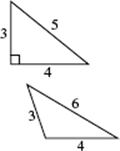
4. (C) Column A: (a + b)2 = a2 + 2ab + b2 = a2 + b2 (since ab = 0).
Column B: (a – b)2 = a2 – 2ab + b2 = a2 + b2 (since ab = 0).
The columns are equal (C).
**Use TACTIC 1, Chapter 12: Pick two numbers whose product is 0; say a = 0 and b = 1. Then (a + b)2 = (0 + 1)2 = 1 and (a – b)2 = (0 – 1)2 = 1. Eliminate A and B and try other values where either a or b is 0 (since ab = 0). The two expressions are always equal.
5. (B) Since d divisions each have t teams, multiply to get dt teams; and since each team has p players, multiply the number of teams (dt) by p to get the total number of players: dtp.
**Use TACTIC 2, Chapter 11. Pick three easy-to-use numbers for t, d, and p. Assume that there are 2 divisions, each consisting of 4 teams, so, there are 2 × 4 = 8 teams. Then assume that each team has 10 players, for a total of 8 × 10 = 80 players. Now check the choices. Which one is equal to 80 when d = 2, t = 4, and p = 10? Only dtp.
6. (B) There are nine positive integers less than 10: 1, 2, …, 9. For which of them is ![]() ? Only 1 and
? Only 1 and ![]() and
and ![]() . When x = 3,
. When x = 3, ![]() , and for all the others
, and for all the others ![]() . The probability is
. The probability is ![]() .
.
7. (B) Solve the given equation: ![]()
Add the fractions: ![]()
Multiply both sides by a: 3 = 12a
Divide both sides by 12: ![]()
**You can use TACTIC 1, Chapter 11: back- solve; try Choice C. If ![]() , then
, then ![]() , so the left-hand side equals 9. That’s too small. Now, be careful: a fraction gets bigger when its denominator gets smaller [KEY FACT B4]. Eliminate Choices C, D, and E, and try a smaller value for
, so the left-hand side equals 9. That’s too small. Now, be careful: a fraction gets bigger when its denominator gets smaller [KEY FACT B4]. Eliminate Choices C, D, and E, and try a smaller value for ![]() works.
works.
8. (D) Use TACTIC 4, Chapter 12. Could y = 20? Yes, if the large triangle were equilateral, x would be 30 and y would be 20. Must y = 20? No, if x = 45, y = 10. (Note: Since the figure may not be drawn to scale, the triangle could be any triangle with a 60° angle.) Neither column is always larger, and the columns are not always equal (D).

9. (B) You don’t have to solve for a and b. If a – b > a + b, then b is negative and Column B is greater.
**You could solve. Adding the two equations yields
2a = 49 ⇒ a = 24.5 ⇒ b = –.5.
10. (C) Since, in 1990, 2p pounds of potatoes cost ![]() d dollars, p pounds cost half as much:
d dollars, p pounds cost half as much: ![]() . This is
. This is ![]() , or 25%, as much as the cost in 1980, which represents a decrease of 75%.
, or 25%, as much as the cost in 1980, which represents a decrease of 75%.
**In this type of problem it is often easier to use TACTIC 2, Chapter 11. Assume that 1 pound of potatoes cost $100 in 1980. Then in 1990, 2 pounds cost $50, so 1 pound cost $25. This is a decrease of $75 in the cost of 1 pound of potatoes, and .
.
11. (C) Adding the two given equations, we get a + b + c = 11d. Then
The columns are equal (C).
12. (A) Since in the given figure OA and OB are radii, each is equal to 5. With no restrictions on x, AB could be any positive number less than 10; and the larger x is, the larger AB is. If x were 90, AB would be ![]() , but we are told that x > 90, so
, but we are told that x > 90, so ![]() .
.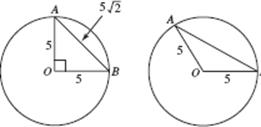
13. (A) Column B = ![]() = (x5)5 = x25.
= (x5)5 = x25.
Since 0 < x < 1, x25 < x.
14. (B) Family A would be expected to pay $10,800, the full annual cost for a 4-year public university. Family B would be expected to pay approximately $3,500. Therefore, family A would pay $10,800 – $3,500 = $7,300 more.
15. (B) The average expected family contribution of a family with an income between $50,000 and $59,000 is about $7,500. Since the average cost of attending a 4-year public university is $10,800, there is an unmet need of $10,800 – $7,500 = $3,300.
16. (C) To compare two fractions, cross-multiply. Since ![]() and 2 × 6 = 12, the two fractions have the same value. The columns are equal (C).
and 2 × 6 = 12, the two fractions have the same value. The columns are equal (C).
17. (C) In Figure 1, since the radius of each circle is 3, the area of each circle is 9π, and the total area of the four circles is 36π. In Figure 2, the radius of each circle is 2, and so the area of each circle is 4π, and the total area of the nine circles is 36π. In the two figures, the white areas are equal, as are the shaded areas. The columns are equal (C).
18. (D) If Jason were really unlucky, what could go wrong in his attempt to get one marble of each color? Well, his first nine picks might yield five blue marbles and four white ones. But then the tenth marble would be red, and now he would have at least one of each color. The answer is 10.
19. (E) If a represents Jordan’s average after 5 tests, then he has earned a total of 5a points [TACTIC E1]. A grade of 70 on the sixth test will lower his average 4 points to a – 4. Therefore,![]() .
.
**Assume Jordan’s average is a because he earned a on each of his first 5 tests. Since after getting a 70 on his sixth test his average will be a – 4, the deviation on each of the first 5 tests is 4, for a total deviation above the average of 20 points. So, the total deviation below must also be 20 [KEY FACT E3]. Therefore, 70 is 20 less than the new average of a – 4:
70 = (a – 4) – 20 ⇒ a = 94.
**Use TACTIC 1, Chapter 11: backsolve. Start with Choice C, 86. If his 5-test average was 90, he had 450 points and a 70 on the sixth test would give him a total of 520 points, and an average of 520 ÷ 6 = 86.666. So, the 70 lowered his average 3.333 points. That’s not enough. Eliminate Choices A, B, and C. Try Choices D or E. Choice E, 94, works.
20. (B) Reading from the top graph, we get the following enrollment figures:
|
1970 |
1988 |
|
|
Public PreK–8 |
33,000,000 |
28,000,000 |
|
Public 9–12 |
13,000,000 |
12,000,000 |
|
Private PreK–8 |
4,000,000 |
4,000,000 |
|
Private 9–12 |
1,000,000 |
1,000,000 |
|
Total |
51,000,000 |
45,000,000 |
21. 51,000,000 – 45,000,000 = 6,000,000.
22. (B) In 1988, 8,800,000 (22% of 40,000,000) students lived in the West. From 1988–1998 this figure increased by 27%—for simplicity use 25%: an additional 2,200,000 students; so the total was then 11,000,000. The projected increase from 1998–2008 is about 10%, so the number will grow by 1,100,000 to 12,100,000.
23. (D) 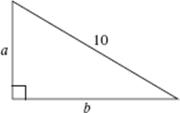
By the Pythagorean theorem, a2 + b2 = 102 = 100;
and since the area is 20, ![]() .
.
Expand:
(a + b)2 = a2 + 2ab + b2 = (a2 + b2) + 2ab.
Then
(a2 + b2) + 2ab = 100 + 2(40) = 180.
24. (D) Let r, C, and A represent the radius, circumference, and area of the circle.![]()
Similarly,![]()
The value of Column A is 2r, and the value of Column B is r2. Which is greater? Dividing each by r, yields 2 in Column A and r in Column B. Since there are no restrictions, r could be greater than, less than, or equal to 2. Neither column is always greater, and the two columns are not always equal (D).
**Use TACTIC 1, Chapter 12. Let r = 1. Then, C = 2π and A = π; so a = 2 and b = 1. Column B is greater: eliminate A and C. Try r = 2. Now, C = 4π and A = 4π; a = b and the columns are equal. Eliminate Choice B. The answer is D.
25. (C) If r is the radius of the white circle, 2r is the radius of the shaded semicircle. The area of the white circle is πr2. The area of the semicircle is ![]() , so the area of the shaded region is 2πr2 – πr2 = πr2. The columns are equal (C).
, so the area of the shaded region is 2πr2 – πr2 = πr2. The columns are equal (C).

**The solution is even easier if you use TACTIC 1, Chapter 12. Let the radius of the circle be 1 instead of r, and proceed as above. The area of each region is π.
26. (C) If there are x seats on each bus, then the group is using ![]() seats. After
seats. After ![]() of them get off,
of them get off, ![]() of them, or
of them, or ![]() remain.
remain.
What fraction of the 2x seats on the two buses are now being used? ![]() .
.
**To avoid the algebra, assume there are 20 seats on each bus. At the beginning, the group is using 48 of the 60 seats on the three buses. When 12 people left, the 36 remaining people used ![]() of the 40 seats on two buses.
of the 40 seats on two buses.
27. (E) To find the average of three numbers, divide their sum by 3: ![]() . Now use the distributive law and divide each term in the numerator by 3:
. Now use the distributive law and divide each term in the numerator by 3: ![]() .
.
28. (B) In the given figure, the diameters of the four small semicircles are 2, 4, 6, and 8, so the diameter of the large semicircle is 2 + 4 + 6 + 8 = 20, and its radius is 10. The perimeter of the shaded region is the sum of the circumferences of all five semicircles. Since the circumference of a semicircle is π times its radius, the perimeter is π + 2π + 3π + 4π + 10π = 20π.
29. (A) a + 25%(a) = 1.25a, and b – 25%(b) = 0.75b.
So, 1.25a = .75b, and ![]()
**If after increasing a and decreasing b the results are equal, a must be smaller than b. So, the ratio of a to b must be less than 1. Eliminate Choices C, D, and E. Now, either test Choices A and B or just guess. To test Choice B, pick two numbers in the ratio of 3 to 4—30 and 40, for example. Then, 30 increased by 25% is 37.5, and 40 decreased by 25% is 30. The results are not equal, so eliminate Choice B. The answer is ![]() . (50 decreased by 25% is 37.5.)
. (50 decreased by 25% is 37.5.)
Section 3—Analytical Writing
There are no “correct answers” to this section.
